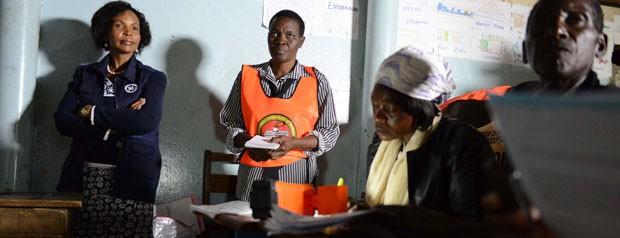Sudan’s Colonized Judiciary
It’s an unfortunate reality that books on Sudan by Sudanese authors””even those who have a wonderful English writing style, and who deal with their subject matter in a way that combines insight with accessibility””rarely get the attention they deserve. We should take a close look at Abdullahi Ibrahim’s recently-published history of the Sudanese judiciary: Manichaean Delirium: Decolonizing the Judiciary and Islamic Renewal in the Sudan, 1898-1985, (Leiden, Brill, 2008). 
Abdullahi writes as an insider to Sudan’s Islamist intellectual and political tradition, and illuminates why not only the law, but the judiciary as well, was an arena of such significant political contest in colonial and post-colonial Sudan. He places contemporary Sudan within the wider post-colonial experience, using Frantz Fanon’s paradigms of the opposition between the European/canonical and the native/deviant, using the divided judiciary as his case.
British rule in Sudan, as elsewhere, was marked by a talent for divide and rule. This has been much-remarked in the context of the “˜native administration’ system, developed in the 1920s in order to marginalize the educated “˜detribalized’ elites whom, the British feared, would challenge their rule. The rural aristocracy was empowered””within very strictly defined limits””and became tarnished as “˜collaborators’ within the dominant nationalist political discourse. Sharia judges were also allocated their tightly-defined status within the system: low.
Abdullahi documents how the colonial subjects’ experience of British rule was hierarchically ordered, from matters of dress to education to urban geography. He poses a set of dualities. The colonizers and their carefully-chosen effendi clients wore suits and polished shoes (jazma), while the rest wore jellabiyas and markubs“”and could be punished for violating the dress code. Khartoum was the modern city, laid out in a grid (with diagonals, said to resemble the Union Jack), while Omdurman the “˜native’ town retained its disorderly street plan. (To this day the executive is in Khartoum and the legislature on the other side of the river.) The administration used the Gregorian calendar and collected regular taxes and dues; the traditional system used the Islamic calendar and collected the Islamic Zakat. Students destined for prestigious posts attended the secular Gordon Memorial College close to the Governor-General’s Palace in Khartoum, those relegated to local affairs went to the Mahad al Ilmi (Islamic College) in Omdurman.
Abdullahi’s account is made particularly vivid by his gift for anecdote and personal observation. He recounts a story told by an old folklorist whose life story he compiled, describing how the schoolboys of Khartoum turned out for a parade in honor of a British colonial official. After long waiting in the sun, the officer arrived on his horse, inspected the schoolboys from the government schools but wheeled away at the very point where he came to the ranks of the boys from the khalwas (Quranic schools), who went away aggrieved, “˜staring into the void drilled by the refusal of that British official, the symbol of power and legitimacy, even to take notice of our presence.’
Abdullahi’s chief concern is how this duality translated into the legal sphere, relegating Islamic Law and its courts to second class status and a domestic sphere. Instead of being a nationally unifying factor, Sharia became a divisive issue. The qadis (judges) of the Sharia Division were junior to the “˜authoritative’ Civil Division. Qadis were required to wear a version of traditional garb including a turban (a dress code that some later adopted as a defiant gesture against western mores), were not entitled to receive salutes from policemen, and were widely ridiculed as “˜women’s judges.’ This refers to how the Sharia courts were visibly “˜women’s courts’, crowded with abandoned wives and their children and dispossessed widows hoping for the near-impossible to occur. Abdullahi notes that women preferred the Sharia courts to the tribal courts because Islamic law gives them more rights.
Imperial Sudan possessed neither a unified legal code nor a single judicial system. Among the majority, the sense of moral injury generated by the distinct second-class status of their own customary legal system, generated a rage for justice, unmet in the formal courts. Post-colonial Sudan was little different: the ruling secularized elites despised the Sharia courts, insensitive to their political plight and history. From the first days of independence, the search for a unified judiciary became a central theme of Sudanese politics. Abdullahi describes how this struggle translated into a “˜rage for masculinity’ and a preoccupation with sexual morality (including especially prostitution and homosexuality) in public discourse. It is not insignificant that Hassan al Turabi is the son of a qadi. Abdullahi breaks new ground in situating Turabi’s political philosophy in his family background.
In two provocative chapters, Abdullahi provides an Islamist perspective on the politics of Nimeiri’s Islamism. He is critical of the Republican Brothers’ leader Mahmoud Mohamed Taha, for repudiating the Islamic courts””rubbing in their faces the fact of their colonial origin and their inability to implement their ruling, made in 1968, that he was an apostate. Abdullahi describes the popular support for Sharia as stemming more from people’s hostility to the (secular) courts with their slow and expensive procedures, than enthusiasm for Islam. Nimeiri’s September Laws held out the promise of a unified judiciary, but disappointed. Abdullahi concludes by noting that Sudanese political society remains in a Manichean trap, and implies that a certain madness, a “˜logic of daring,’ will be needed to escape from it.
We are planning a debate on Abdullahi Ibrahim’s book and the deep questions about the Sudanese judiciary that it raises.







What Mr. Ibrahim describes well enough is the History of the Judicial system, but what is not taken into account is the evolution of the current system. The current system is a mutation of both, neither serving the purpose of “the women” nor the civilians. It has been plaqued by corruption, and the ability to diverge judgements on bribery and influence (either political or social). Just like the remaining history of the country, any attempt to scientifically disect the course of events will be hazy, for things in Sudan are haphazard and occur at random.
Being an English born Sudanese, I have devoted much of the past 4 years delving into the Post colonial judicial system, and constitution and the government of Sudan. This book is very well written and i applaud the time and effort that must have gone into the writing of the book. However i do agree with Mr Ahmed, where the current judicial system is now is not displayed in the book.
A great read otherwise.